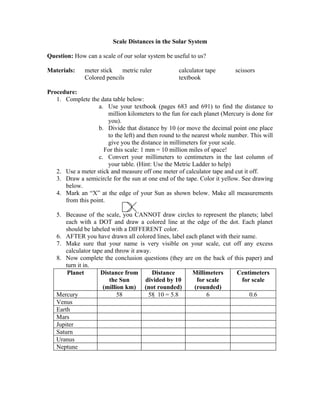
Scale Distances In The Solar System
- 1. Scale Distances in the Solar System Question: How can a scale of our solar system be useful to us? Materials: meter stick metric ruler calculator tape scissors Colored pencils textbook Procedure: 1. Complete the data table below: a. Use your textbook (pages 683 and 691) to find the distance to million kilometers to the fun for each planet (Mercury is done for you). b. Divide that distance by 10 (or move the decimal point one place to the left) and then round to the nearest whole number. This will give you the distance in millimeters for your scale. For this scale: 1 mm = 10 million miles of space! c. Convert your millimeters to centimeters in the last column of your table. (Hint: Use the Metric Ladder to help) 2. Use a meter stick and measure off one meter of calculator tape and cut it off. 3. Draw a semicircle for the sun at one end of the tape. Color it yellow. See drawing below. 4. Mark an “X” at the edge of your Sun as shown below. Make all measurements from this point. 5. Because of the scale, you CANNOT draw circles to represent the planets; label each with a DOT and draw a colored line at the edge of the dot. Each planet should be labeled with a DIFFERENT color. 6. AFTER you have drawn all colored lines, label each planet with their name. 7. Make sure that your name is very visible on your scale, cut off any excess calculator tape and throw it away. 8. Now complete the conclusion questions (they are on the back of this paper) and turn it in. Planet Distance from Distance Millimeters Centimeters the Sun divided by 10 for scale for scale (million km) (not rounded) (rounded) Mercury 58 58 10 = 5.8 6 0.6 Venus Earth Mars Jupiter Saturn Uranus Neptune
- 2. Conclusion Questions for Scale Distance Lab: 1. Are the distances greater between the inner planets or the outer planets? 2. Between which two neighboring planets is the greatest distance? 3. From your model, explain why scientists use the terms inner and outer planets. 4. The Asteroid Belt is located between Mars and Jupiter. Add them to your scale model using very small dots (You may add them about mid-way point between Mars and Jupiter). If you need more information about the Asteroid Belt, look in your book! How far from the sun is the asteroid belt? 5. Explain why it takes 3 years to travel to Mars from Earth, based on your new knowledge of distances. 6. Estimate how long it will take to travel from Earth to Jupiter, base your response on your model.